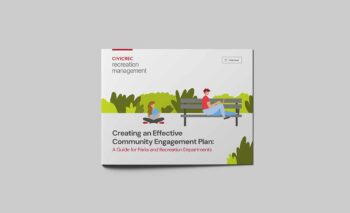5 Ways to Boost Parks and Recreation Participation in 2024
Public park and recreation spaces offer invaluable opportunities for residents to relax in nature, participate in social activities, and meet their fitness goals — but that doesn’t mean everyone in your community is taking advantage of what you have to offer.
For many park and recreation departments, especially special districts, resources are limited. Marketing your public programming can be a challenge. But while some residents aren’t aware of classes, events, and other activities, others may simply have difficulty signing up.
So — what strategies can you use to increase resident engagement? This article outlines some great approaches to community engagement and inclusivity that can boost park and recreation participation, registrations, and revenue.
1. Make Digital Transactions Easy
Residents are more likely to register for your programming if you make it easy for them to do so. Providing a single online location to learn about, sign up, and pay for activities is essential. When residents have to make an in-person office visit or fill out paper forms, it discourages programming participation and creates barriers for busy community members who would otherwise be eager to take part.
2. Leverage Community Engagement Tools
In some cases, a lack of participation could mean that there’s little demand for your program offerings within your community. With community engagement tools, park and recreation teams can collect feedback and information directly from the residents they serve to learn more about what they’re looking for. This can take the guesswork out of seasonal planning, allowing you to prepare the types of activities that community members will find the most value in.
3. Prioritize Web Accessibility
If residents with visual, auditory, and cognitive disabilities aren’t able to navigate your web content, it can end up excluding them from your program offerings. It’s vital to use web accessibility tools to ensure that everyone can easily register for your activities online. By making online access to content and registration possible for people living with disabilities, you not only increase programming participation, but promote a more inclusive community overall. It’s the right thing to do, and it’s the law under the Americans with Disabilities Act (ADA).
On a related note, it’s also legally required to ensure the accessibility of park and recreation facilities for those with physical disabilities. If your public spaces aren’t meeting ADA standards, it’s time to put a plan in place to improve accessibility.
Related Resource – Free Web Accessibility Scan
4. Promote Diversity and Inclusion for Marginalized Groups
No resident should ever feel excluded from a community’s civic experience. Prioritizing ongoing diversity and inclusion training for park and recreation professionals can help staff understand the need for greater inclusivity in the world at large, leading to informed decisions that better serve all residents.
By providing more welcoming spaces and enabling broader participation, park and recreation teams can not only see increased participation in their programming but also take a monumental step forward towards uniting their communities, making them safer and more supportive for all.
5. Develop Community Outreach Strategies
No one will benefit from your programs and facilities if they aren’t aware of them. Take the time to prepare effective community outreach strategies so more residents can learn about your park and recreation offerings. This might include forming partnerships with local schools, businesses, non-profits, and other organizations to co-host events and programs. Collaborations can help reach a wider audience and provide additional resources to increase registrations and tailor your program offerings for the community.
Related eBook – 3 Unique Ways to Boost Community Outreach in Your Area
Bring Your Community Together with Quality Programming, Step by Step
While park and recreation departments and special districts often function on tight budgets, that doesn’t mean they have to be short on tactics to get more residents involved with everything they have to offer. From technology that modernizes the process of registering for activities to initiatives that improve the accessibility and inclusivity of your programming, there are many low-cost strategies that can help you reach more residents and appeal to what they’re looking for from park and recreation opportunities.
The more people are able to access and enjoy thriving park and recreation spaces, the more it benefits your community — making these approaches well worth your time and effort.
Related Brochure – Your All-in-One Recreation Software Solution
More Solutions for Municipal Recreation Planning and Management
Discover even more ways to improve recreation and add benefits to your community.


